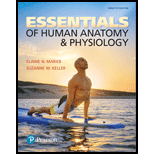
Concept explainers
More than one choice may apply.
The major endocrine organs of the body
a. tend to be very large organs.
b. are closely connected with each other.
c. all contribute to the same function (digestion).
d. tend to lie near the midline of the body.
Introduction:
The endocrine system is the second control system of the body after nervous system. It releases hormones, which, in turn, regulate complex body processes like growth, metabolism, and reproduction. These hormones are released by major endocrine organs namely, the pituitary, pineal, thyroid, parathyroid, thymus and adrenal glands, pancreas, and gonads.
Answer to Problem 1MC
Correct answer:
Although a few endocrine organs and tissues are situated in the separate regions of the body, all the major endocrine organs are present in the close vicinity of the midline of the human body.
Explanation of Solution
Explanation for the correct answer:
Option (d) is given that all the major endocrine organs lie close to the midline of the body. The major endocrine organs of the body include pituitary, pineal, hypothalamus, thyroid, parathyroid, thymus and adrenal glands, pancreas, and gonads (ovaries and testes) that generally lie in the midline in the anatomical plane of the human body. Hence, option (d) is correct.
Explanation for incorrect answers:
Option (a) is given that endocrine organs tend to be very large. The organs of the endocrine system are of all sizes, some being very small (like pineal and pituitary glands) and others being large (thyroid gland). So, it is an incorrect option.
Option (b) is given that all the endocrine organs are connected to each other. The endocrine organs are situated in different places in the body. So, it is an incorrect option.
Option (c) is given that all organs of the endocrine system control the same function. The endocrine glands exhibit distinct functions. The thyroid gland is involved in the growth and development of body tissues, whereas gonads are for reproductive functions. So, it is an incorrect option.
Hence, options (a), (b), and (c) are incorrect.
The endocrine system consists of organs that are specialized to regulate various body processes. They secrete chemical messengers called hormones, which act on the target cell and control their functions.
Want to see more full solutions like this?
Chapter 9 Solutions
Essentials of Human Anatomy & Physiology (12th Edition)
- C MasteringHealth MasteringNu × session.healthandnutrition-mastering.pearson.com/myct/itemView?assignment ProblemID=17396416&attemptNo=1&offset=prevarrow_forward10. Your instructor will give you 2 amino acids during the activity session (video 2-7. A. First color all the polar and non-polar covalent bonds in the R groups of your 2 amino acids using the same colors as in #7. Do not color the bonds in the backbone of each amino acid. B. Next, color where all the hydrogen bonds, hydrophobic interactions and ionic bonds could occur in the R group of each amino acid. Use the same colors as in #7. Do not color the bonds in the backbone of each amino acid. C. Position the two amino acids on the page below in an orientation where the two R groups could bond together. Once you are satisfied, staple or tape the amino acids in place and label the bond that you formed between the two R groups. - Polar covalent Bond - Red - Non polar Covalent boND- yellow - Ionic BonD - PINK Hydrogen Bonn - Purple Hydrophobic interaction-green O=C-N H I. H HO H =O CH2 C-C-N HICK H HO H CH2 OH H₂N C = Oarrow_forwardFind the dental formula and enter it in the following format: I3/3 C1/1 P4/4 M2/3 = 42 (this is not the correct number, just the correct format) Please be aware: the upper jaw is intact (all teeth are present). The bottom jaw/mandible is not intact. The front teeth should include 6 total rectangular teeth (3 on each side) and 2 total large triangular teeth (1 on each side).arrow_forward12. Calculate the area of a circle which has a radius of 1200 μm. Give your answer in mm² in scientific notation with the correct number of significant figures.arrow_forwardDescribe the image quality of the B.megaterium at 1000X before adding oil? What does adding oil do to the quality of the image?arrow_forwardWhich of the follwowing cells from this lab do you expect to have a nucleus and why or why not? Ceratium, Bacillus megaterium and Cheek epithelial cells?arrow_forward14. If you determine there to be debris on your ocular lens, explain what is the best way to clean it off without damaging the lens?arrow_forward11. Write a simple formula for converting mm to μm when the number of mm's is known. Use the variable X to represent the number of mm's in your formula.arrow_forward13. When a smear containing cells is dried, the cells shrink due to the loss of water. What technique could you use to visualize and measure living cells without heat-fixing them? Hint: you did this technique in part I.arrow_forward10. Write a simple formula for converting μm to mm when the number of μm's are known. Use the variable X to represent the number of um's in your formula.arrow_forward8. How many μm² is in one cm²; express the result in scientific notation. Show your calculations. 1 cm = 10 mm; 1 mm = 1000 μmarrow_forwardFind the dental formula and enter it in the following format: I3/3 C1/1 P4/4 M2/3 = 42 (this is not the correct number, just the correct format) Please be aware: the upper jaw is intact (all teeth are present). The bottom jaw/mandible is not intact. The front teeth should include 6 total rectangular teeth (3 on each side) and 2 total large triangular teeth (1 on each side).arrow_forwardarrow_back_iosSEE MORE QUESTIONSarrow_forward_ios
- Essentials of Pharmacology for Health ProfessionsNursingISBN:9781305441620Author:WOODROWPublisher:Cengage
 Human Physiology: From Cells to Systems (MindTap ...BiologyISBN:9781285866932Author:Lauralee SherwoodPublisher:Cengage Learning
Human Physiology: From Cells to Systems (MindTap ...BiologyISBN:9781285866932Author:Lauralee SherwoodPublisher:Cengage Learning - Lifetime Physical Fitness & WellnessHealth & NutritionISBN:9781337677509Author:HOEGERPublisher:Cengage





